4 Landscape Trends in California Shaped by Climate Change
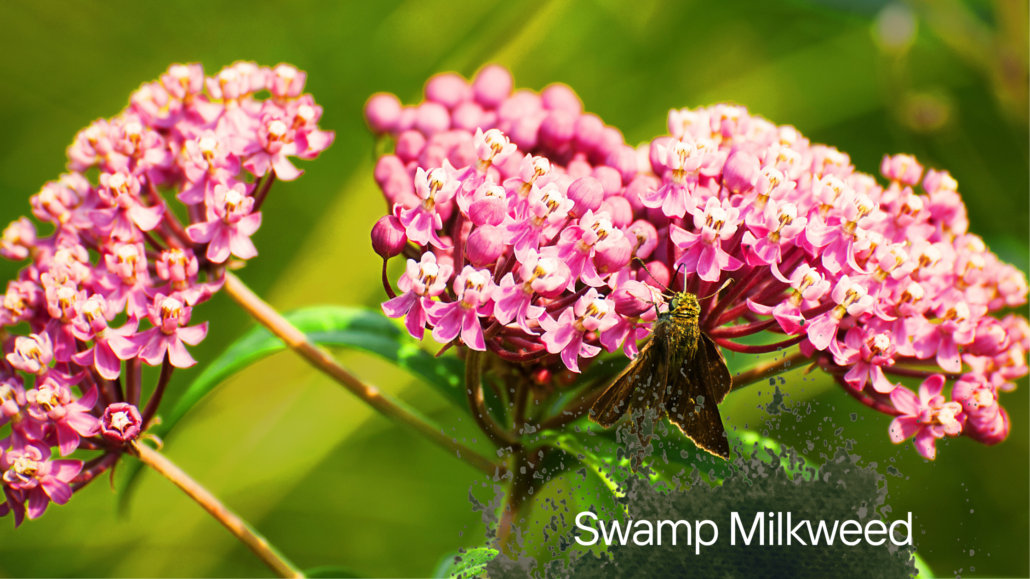
This plant can survive in flooded conditions.
We’ve updated last year’s post on trends to reflect any new or updated ones, focusing on the San Francisco Bay Area.
The big changes for this year have more to do with broad acceptance of the need to adapt landscapes to our changing climate and extreme weather. The result has been that plant material preferences are changing, landscapes overall are adhering to defensible space guidelines, heat waves and flooding. And, water conservation is becoming the norm.
Even though safety is the goal, we like to promote the idea that a beautiful garden with colorful plants is still attainable. (See the illustrations below.)
1. Plant Trends
Because the San Francisco Bay area climate, including the coast, is warming, plant hardiness zones continue to shift. Last year, about half the country moved into a different zone. Plant survival depends on being well-informed about the latest plant research and their changing needs.
Plants need these 3 attributes
Resistance to fire, drought, and extreme heat. Although freezing is not typical for the Bay Area, we may have more incidences of it, and plants need to be able to adapt. Or, we must protect them from freezing temps.
This year, Native plants are more popular, which is good because they’re ideally suited to your environment. In response to this trend, the California Native Plant Society has become more prominent. Check out their website. They’re an invaluable resource.
We found several perennials and natives that meet all the criteria. The images below show a combination of perennials, succulents, and natives that are all fire-resistant, drought-tolerant, and heat-tolerant.
Many are pollinators. See our post on gardening for pollinators.
The images below suggest what plants are most resilient in a warming climate. Many of them are natives. Remember that their ability to thrive will depend on your specific environment.


Master Gardeners say that succulents (see three below) “are well-adapted to Northern California’s dry and mild Mediterranean climate.” The succulents noted below are just a few of the options.

What happens to plants during heat waves
If temperatures rise above 90 degrees, even heat-tolerant plants will show signs of stress. Their ability to recover depends on the treatment and the length of the heat wave.
What plants can tolerate flooding?
Some can. These include Bald Cypress, Red Maple, Buttonbush, Swamp Milkweed (see header photo above), Creeping Jenny, Wild Ginger, and Iris varieties.
What makes plants fire-resistant?
- Deep roots.
- High moisture content (usually shown with thick leaves)
- Thin, watery sap. (low sap/resin)
- Loose and open branching.
- Low growing.
For more details, see our post on Wildfire Preparedness.
Trees — for a changing climate
More people are planting trees this year to alleviate the effects of extreme heat. When considering new trees, heed the experts who suggest you choose the most resilient ones that can survive high winds, droughts, and extreme heat.
The quote below from UC Davis explains what is being done to adapt their public garden trees to a warming climate. “The team is working on ways to conserve the valuable heritage trees. But they’re also seeking to replace others on the campus that are bound to fail with ‘climate-ready’ ones.”
Trees with these characteristics are most likely to ride out extreme weather.
- Lower trees (to the ground) and broader.
- Broad, shallow root systems.
- Rounded or domed canopies.
- Heavy trunks.
- Strong branch connections.
See the illustration below.
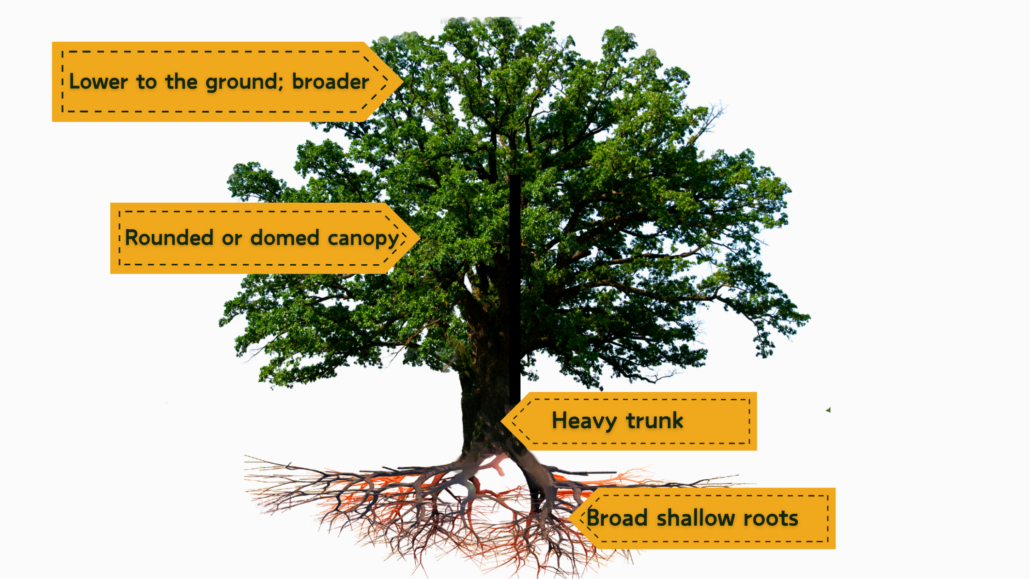
2. Drainage trends
Increased flooding incidences can overload a drainage system. This should be a high priority for homeowners and commercial property managers because a drainage system without the capacity for higher volumes of water will fail. Below is a list of trends and how they are used. A previous post has more detail and photos.
What is Permeable Paving?
This year, permeable concrete has become increasingly popular. It is durable and stylish. Constructed of permeable concrete, porous asphalt, or permeable interlocking concrete paving, it allows water to drain into the ground. The benefits: it reduces runoff, recharges groundwater, and is less expensive. Permeable concrete is an environmentally friendly option. Scroll down for images.
How to improve drainage in planted areas
- A strategically planted area of shrubs, high grasses, and perennials is an environmentally friendly way of capturing and filtering runoff.
- Top dress soil with organic matter such as compost and aerate regularly.
- UC IPM Division recommends adding gravel, organic mulches, or other materials that allow water to be absorbed into the ground.
Grading and Drainage Paths
Grading and drainage paths around a building will direct water away from the foundation. Gravel or rocks are the best materials as they aren’t flammable or attractive.
- Perforated drainage pipes (used in French drains) will collect and drain excess water away from structures and prevent flooding.
- Swales can hold large amounts of runoff from driveways, streets, and parking lots.
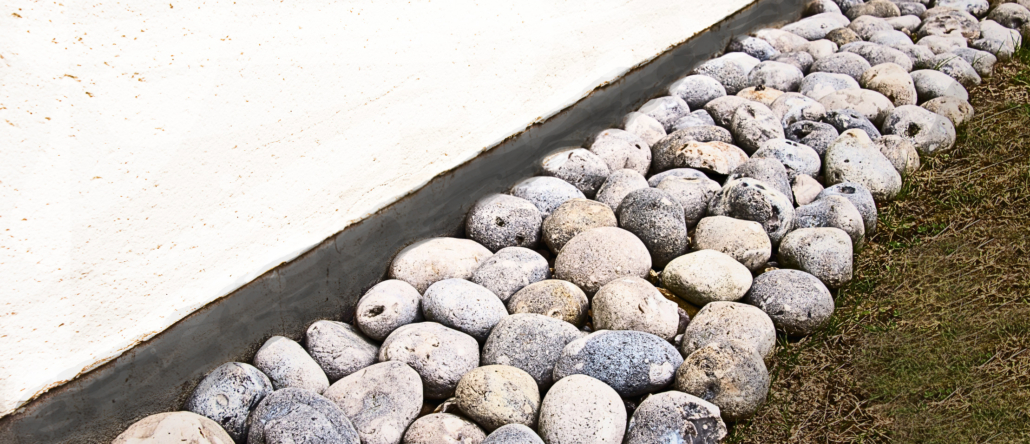
A Note About Materials and Maintenance
Durable materials such as stainless steel, iron, or brass for your drainage grates will look good in the landscape and minimize maintenance headaches. They are critical for keeping debris out but need regular monitoring to ensure they aren’t clogged. Geotextiles can be installed around drainage pipes to help with sediment filtration and enhance your system’s performance.
Regular maintenance, such as inspection and cleaning, will help keep it reliably working.
Retaining walls
A note about retaining walls. They are critical to prevent erosion.
Some trends include
- Incorporating plants with retaining walls.
- Mixing materials such as concrete and wood
- Retaining walls with seating make it multi-functional
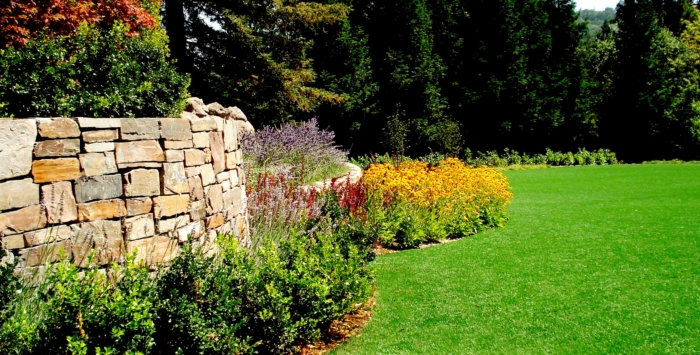
3. Hardscape
Hardscape is trending toward more natural, permeable products and non-combustible materials.
Cool paving technology
There is increasing pressure for new materials to counter the “heat island” effect in urban and suburban areas. Designed to reflect heat, thus lowering surface temperatures. Coating materials such as asphalt or concrete enhance the paver’s heat-reflective properties.
Gravel and grass pavers
It’s a system of interlocking pavers with gaps filled with gravel and/or plant material. They are a type of permeable paver described in section two; this type is cooler and minimizes runoff. Examples below are grass/gravel and permeable pavers.
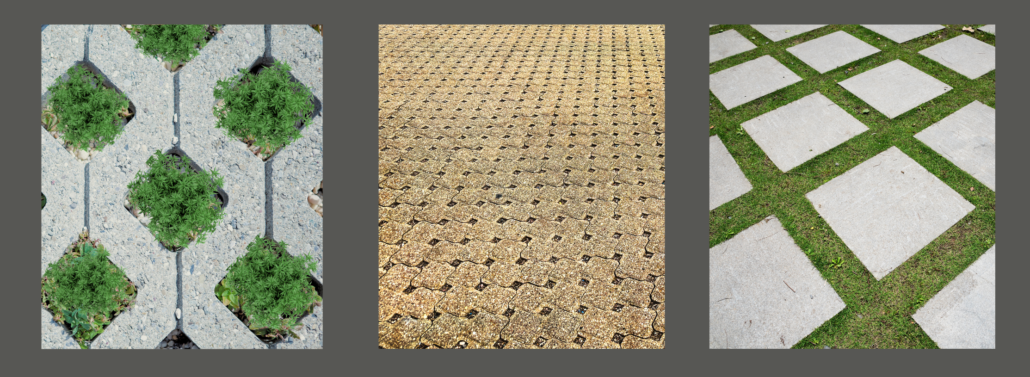
Non-combustible materials
Rocks, gravel, brick, and the ones mentioned above are increasingly used. When used for pathways, these can help to slow the spread of a wildfire.
4. California State Regulations
Ban on gas-powered equipment
The State of California has outlawed the sale of gas-powered mowing and blowing equipment. Though its use hasn’t been banned state-wide, most San Francisco Bay area cities and towns have banned it for now. We are monitoring any new or proposed regulations.
The State has a new water initiative
Called “Make Water Conservation a California Way of Life.”
The goal is to help Californians adapt to climate change. To that end, as of 1/1/2025, each water supplier is required to calculate and comply with the state’s urban water use objective and implement performance measures for commercial, industrial, and institutional properties. Moreover, they are to submit progress reports.
This new regulation is setting standards for both indoor and outdoor water use.
We will pass on information as we know it.
Closing thoughts
Nearly one in three Californians are living in what is termed the “Wildland-Urban Interface.” Four million are in zones vulnerable to wildfire.
The devastating fires in Southern California (in winter) are an uncomfortable reminder that wildfire season is expanding.
Local and state fire departments will update their guidelines, offer incentives to upgrade landscapes, and urge residents to take action to minimize their risk of damage from wildfires.
We will have more information in the coming months.

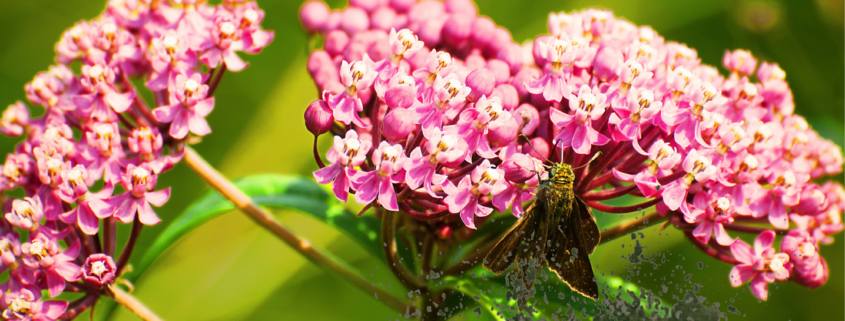

Leave a Reply
Want to join the discussion?Feel free to contribute!